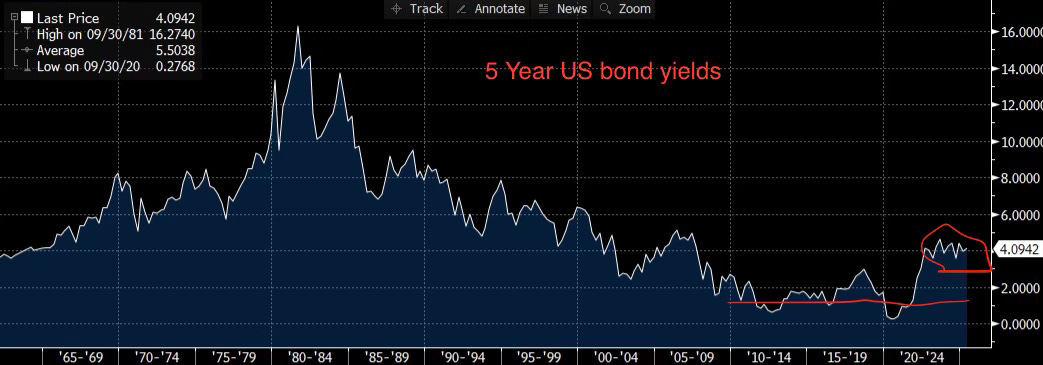Substack Library
GlossaryObservations From Europe
May 13, 2025THIS IS NOT INVESTMENT ADVICE INVESTING IS RISKY AND OFTEN PAINFUL. DO YOUR OWN RESEARCH.
I’m traveling for Kate, writing at a desk in a London hotel room. When much is in flux, I like to know what others are thinking, so in that spirit, here are my thoughts.
-
The goal of White House (WH) policy is power—gaining and maintaining it. The leverage to do so lies in expanding the MAGA movement. The next big test is the midterm elections in 18 months. The goal of the President is to remain at the center of attention. These two facts guide the policy zigzags.
-
The key ingredient to expanding the base is either a) improving income and lowering borrowing costs, or b) satisfying ideological desires. Because the President is trained as an entertainer, however, his own proclivities for drama colors the delivery.
-
Policies that may seem quixotic—simultaneously freeing Jan. 6 protestors, reducing drug costs, attempting to revamp global trade up to the point the financial system almost collapses, supporting Israel, attacking Harvard, and conducting renditions—all satisfy the above rubric.
-
While it may sound ridiculous to those put off by the President, I suspect that, having accomplished every financial, entertainment, and political goal he has set out to achieve, he is now looking to do something even bigger—like upending China the way Reagan is credited with bringing down the Soviet Union, or bringing peace to Ukraine. This means more dramatic shifts in policy are likely. Trying to anticipate what’s next comes back to anchoring on his goals. The higher the stock market goes, the more drama, the lower, the less.
-
Abandoning Musk and the tariffs is now, in retrospect, logical—they no longer helped achieve his goals. Walmart announces earnings in two days and would have been forced to say, if Trump had not reversed the China tariffs, that there would be no school supplies or Christmas ornaments on their shelves. That was intolerable to the WH’s goals. Similarly, after an obscure election for a judge in Wisconsin went against the WH and turned on voter repulsion of Musk, Musk was abandoned.
-
Assuming China can eliminate the fentanyl dealers—which should not be hard—tariffs are likely to settle around 10% on most countries, with numerous carve-outs and exceptions. This will modestly reduce U.S. growth, boost inflation, and modestly reduce global growth. In the WH’s mind, this growth drag will be more than offset by tax cuts and regulatory easing. Indeed, it looks increasingly like changes are on the margin as opposed to fundamental—a few hundred billion dollars of additional deficit spending a year, a few hundred billion dollars of tariff revenue. The big thing is, the U.S. budget deficit is not coming down, which is stimulative to growth as are lower oil prices.
-
Knowing the midterms are coming, the WH may hope that in the next 12 months the economy does a sort of J-curve—slowing enough to get the Fed to ease, then picking up enough to help the WH do better than they are currently expected to in the midterms, which is to lose.
-
Even lower tariffs will raise prices, and I suspect if there is a peep of popular dissent about higher inflation, tariffs can fall yet further—which would be an upside surprise for stocks and bonds. What we now know is that the appetite for drama is high, but for fundamental disruption, it is low.
-
In the background, AI continues to boost productivity and reduce labor costs. Based on Q1 earnings, those companies at the epicenter of this shift are in a white-hot boom, even though their stocks are down this year.
-
Overall, stocks are expensive, but the professional community is underinvested.
-
Bond yields are high relative to their post-2008 history. Essentially, bond yields fell close to zero for the better part of a decade. COVID-induced inflation boosted them to where they are now, and they have essentially stayed in a range for years. Assuming tariffs modestly slow growth and AI modestly slows labor costs, it seems reasonable that bond yields will drift toward their pre-COVID levels.
-
Foreign investors are unsettled by how erratic U.S. policy has been. Over time, asset allocation committees will seek more diversification but will also be constrained by the relatively meager supply of non-dollar investment options. This suggests gradual downward pressure on the dollar, particularly when the Fed eases—perhaps in the fall.
-
The only way I know to navigate such an environment is to be adroit.

